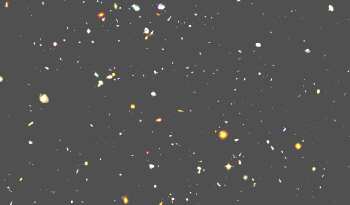New observations suggest that massive galaxies probably formed much earlier than previously thought.

Pictured: Hubble Ultra Deep Field. The image was taken in visible light by the Hubble Space Telescope. You can see a multitude of galaxies, where we see the most distant ones as they were, when the universe was only a few billion years old.
New observations suggest that massive galaxies likely formed much earlier than previously thought. Two teams of astrophysicists have discovered massive galaxies with a redshift of more than 1.5, meaning they formed before the universe was a quarter of its current age. The results do not agree with the accepted model of galaxy formation, called the hierarchical model.
The hierarchical model holds that large galaxies were formed as a result of the merger of smaller galaxies. According to the model, the massive galaxies should appear relatively late in the history of the universe, when it was about half its current age. Astronomers are able to calculate the age of a galaxy by measuring its redshift. Galaxies with a large redshift are older and more distant than those with a small redshift.
However, it is difficult to discover galaxies with a large redshift, because their light is very weak and the radiation they emit is diverted to long wavelengths, which are absorbed by the Earth's atmosphere. Thus, although astronomers can easily measure bright star-forming galaxies at redshifts up to about 6.6, the most distant massive galaxy discovered so far is a galaxy with a redshift of 1.552, discovered 10 years ago.
To overcome this problem, Andrea Cimatti of the National Institute of Astrophysics in Italy (INAF) and his colleagues looked for massive galaxies (having a mass of ten to the eleventh power to ten to the power of twelve solar masses) with a redshift greater than 1.5 by comparing the spectra of them with the spectra of modern massive galaxies. Kimetti and his colleagues, working with the VLT (Very Large Telescope) from the European Southern Observatory in Chile, conducted a survey of an area of the sky known as the Hubble Ultra Deep Field. They identified four massive globular galaxies with a redshift ranging from 1.6 to 1.9.
At the same time, Karl Glazebrook of Johns Hopkins University and his colleagues, using the Gemini telescope in Hawaii, studied a new sample of 150 galaxies from the collection of observations, called the Gemini Deep Survey. These galaxies have a redshift of between 0.8 and 2, and they are from the period of only about three billion years after the big bang. Glazebrook and his colleagues discovered that a significant percentage of galaxies with a redshift greater than 1.5 were massive.
For an article on Physics web
Translation: Dikla Oren
